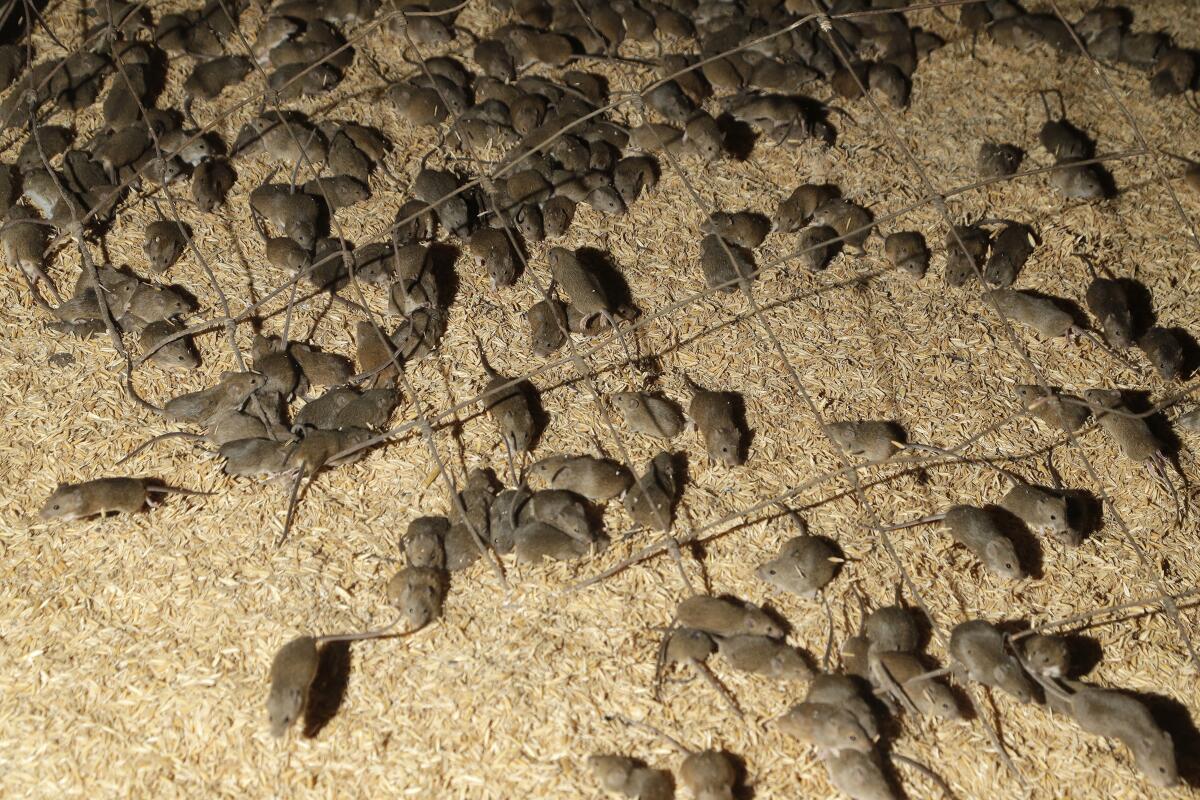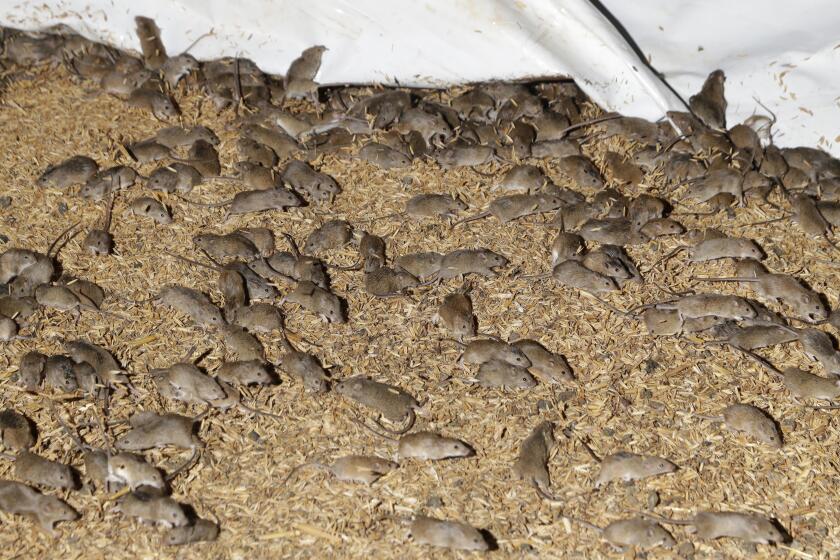Plague of ravenous, destructive mice torments Australian state

- Share via
BOGAN GATE, Australia — At night, the floors of sheds vanish beneath carpets of scampering mice. Ceilings come alive with the sounds of scratching. One family blamed the burning down of their house on mice chewing electrical wires.
Vast tracts of land in Australia’s New South Wales state, home to Sydney, are being threatened by a mouse plague that the state government describes as “absolutely unprecedented.” Just how many millions of rodents have infested the agricultural plains across the state is guesswork.
“We’re at a critical point now where if we don’t significantly reduce the number of mice that are in plague proportions by spring, we are facing an absolute economic and social crisis in rural and regional New South Wales,” Agriculture Minister Adam Marshall said this month.
Bruce Barnes said he is taking a gamble by planting crops on his family farm near the central New South Wales town of Bogan Gate.
“We just sow and hope,” he said.
The risk is that the mice will maintain their numbers through the Southern Hemisphere winter and devour the wheat, barley and canola before it can be harvested.
A blue light affixed to a mouse’s skull flicks on.
NSW Farmers, the state’s top agricultural association, predicts that the plague will wipe more than 1 billion Australian dollars ($775 million) from the value of the winter crop.
The state government has ordered 1,320 gallons of the normally banned poison Bromadiolone from India. Australia’s federal regulator has yet to approve emergency applications to use the poison on the perimeters of crops. Critics fear the poison will kill not only mice but also animals that feed on them, including wedge-tail eagles and family pets.
“We’re having to go down this path because we need something that is super-strength, the equivalent of napalm, to just blast these mice into oblivion,” Marshall said.
The plague is a cruel blow to farmers in Australia’s most populous state, who have been battered by fires, floods and pandemic disruptions in recent years, only to face the new scourge of the non-native house mouse, or Mus musculus.
Navy says rodent population down after rains last winter led to spike in numbers
The same government-commissioned advisors who have helped farmers cope with the drought, fire and floods are returning to help people deal with the stresses of mice.
The worst comes after dark, when millions of mice that had been hiding and dormant during the day become active.
By day, the crisis is less apparent. Patches of road are dotted with squashed mice from the previous night, but birds soon take the carcasses away. Still, haystacks are disintegrating because of ravenous rodents that have burrowed deep inside. Upending a sheet of scrap metal lying in a paddock will send a dozen mice scurrying. The sidewalks are strewn with dead mice that have eaten poisonous bait.
But a constant, both day and night, is the stench of mouse urine and decaying flesh. The smell is people’s greatest gripe.
Two billion voracious rodents have invaded farms in one province. Villagers retaliate with clubs, traps and poison.
“You deal with it all day. You’re out baiting, trying your best to manage the situation, then come home and just the stench of dead mice,” said Jason Conn, a fifth-generation farmer near Wellington, in central New South Wales.
“They’re in the roof cavity of your house. If your house is not well-sealed, they’re in bed with you. People are getting bitten in bed,” Conn said. “It doesn’t relent, that’s for sure.”
Colin Tink estimated that he drowned 7,500 mice in a single night last week in a trap he set with a cattle feeding bowl full of water at his farm outside Dubbo.
“I thought I might get a couple of hundred. I didn’t think I’d get 7,500,” Tink said.
Start your day right
Sign up for Essential California for the L.A. Times biggest news, features and recommendations in your inbox six days a week.
You may occasionally receive promotional content from the Los Angeles Times.
Barnes said mouse carcasses and excrement in roofs were polluting farmers’ water tanks.
“People are getting sick from the water,” he said.
The mice are already in Barnes’ hay bales. He’s battling them with zinc phosphide baits, the only legal chemical control for mice used in broad-scale agriculture in Australia. He’s hoping that winter frosts will help contain the numbers.
Government researcher Steve Henry, whose agency is developing strategies to reduce the impact of mice on agriculture, said it is too early to predict what damage will occur by spring.
He travels across the state holding community meetings, sometimes twice a day, to discuss the mice problem.
“People are fatigued from dealing with the mice,” Henry said.
More to Read
Sign up for Essential California
The most important California stories and recommendations in your inbox every morning.
You may occasionally receive promotional content from the Los Angeles Times.














